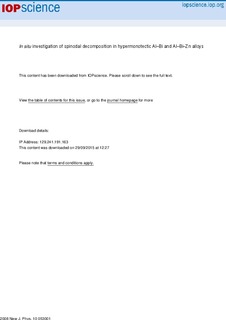| dc.description.abstract | Spinodal decomposition of hypermonotectic Al–6 wt.%Bi,
Al–8 wt.%Bi and Al–6 wt.%Bi–8 wt.%Zn alloys has been investigated using
synchrotron radiography. In the case of the 6 and 8 wt.%Bi binary alloys
undercoolings of 70 and 110 K, respectively, were required to initiate the
L ! L1 + L2 reaction, which appeared to occur very close to the monotectic
reaction temperature. The nucleated L2 droplets were set in collective sizedependent
motion by forces coupled to external fields (gravity and imposed
temperature gradient) as well as forces arising due to internal fluctuations of
the system. With experimental conditions similar to those realized during strip
casting of the same materials, it was found that the size-dependant droplet
velocity field combined with Stokes drag at the L1–L2 interfaces as well
as attractive and repulsive diffusion-coupling between adjacent L2 droplets,
yield complex meso- to microscale hydrodynamics. The hydrodynamics are
the dominating mechanisms for L2 droplet coagulation, and are accordingly
decisive for the final size distribution and geometrical dispersion of the soft
Bi-rich component in the cast material. A different decomposition mode was
observed in the Al–6 wt.%Bi–8 wt.%Zn ternary alloy, with the L2 droplets
undergoing an immiscible–miscible–immiscible transition. In contrast to what was found for the binaries, L2 domains formed at relatively small undercoolings,
and very little droplet motion was observed, as all L2 domains nucleated and
remained on the crucible walls until they encroached on the monotectic front.
At small distances from the monotectic front a Zn-rich solute boundary layer
preceding the -Al, caused the L2 domains to dissolve as Bi–Zn–Al regains
complete miscibility upon reaching a critical Zn-concentration. In the shallow
mush region behind the monotectic reaction, a high Zn solid solubility and a
relatively fast diffusion of Zn in -Al combine to cause a rapid diminishing Zn
concentration in the mush liquid, restoring Bi-immiscibility and consequentially
a secondary nucleation of L2 droplets in the mush. | nb_NO |
